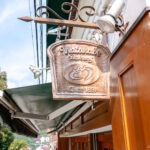This post may contain affiliate links. Please read our disclosure policy.
At Suzuhiro Kamaboko Museum in Odawara, learn the history of Japanese fish cakes, watch the factory in action, and join a fun hands-on workshop.

What Is Kamaboko?
Kamaboko is a traditional Japanese fish cake made from surimi, a paste of minced white fish. It comes in many shapes, from the familiar half-moon loaves to narutomaki, the swirly slices you often see floating in ramen bowls.
Chikuwa, another style, is shaped by wrapping fish paste around a stick and grilling it until firm and golden. Both are everyday foods in Japan, found in oden, udon, and even convenience store lunch boxes.
Explore the Museum

Suzuhiro, founded in 1865, is one of Japan’s oldest kamaboko makers. The museum showcases the craft and culture behind fish cakes through interactive exhibits, a viewing gallery of the factory, and engaging displays about the science of surimi.
We especially enjoyed the “12 Secrets of Kamaboko” exhibit, where we learned that Odawara’s pure Hakone water helps give local kamaboko its delicate flavor.
Join a Fish Cake Workshop

The highlight of our visit was the hands-on workshop. Under the guidance of staff, each of us shaped a kamaboko on a wooden board and wrapped chikuwa paste around a stick. It was trickier than it looked, but so much fun.
Once finished, the kamaboko was steamed for about an hour, while the chikuwa was grilled in just 20 minutes. During the wait, we had time to explore the rest of the museum and grab lunch nearby. Reservations are recommended and can be made online.
Watch the Factory in Action

Through large glass windows, we watched the factory floor where skilled workers shaped, steamed, and packaged kamaboko. Seeing the process on a larger scale gave us a new appreciation for this everyday food.
Beyond the Museum: Suzuhiro Kamaboko Village

The museum is part of a larger Suzuhiro complex, which makes it easy to spend a few hours here.
- Main Kamaboko Shop – A wide selection of beautifully packaged fish cakes, perfect for gifts
- Suzunari Market – Local produce, delicacies, and free food samples
- Restaurants and Hakone Beer Brewery – A good stop for lunch or a tasting while you wait for your workshop creations
How to Get to Suzuhiro Kamaboko Museum
Suzuhiro Kamaboko Museum is in Odawara, on the Hakone Tozan Railway at Kazamatsuri Station.
By Train
- From Hakone-Yumoto: Take the Hakone Tozan Railway toward Odawara and get off at Kazamatsuri Station. The ride is about 8 minutes.
- From Kazamatsuri Station: Exit the gates and follow signs for Suzuhiro Kamaboko no Sato. It is a 2 to 3 minute walk via the pedestrian overpass to the museum entrance.
By Car
- About 1 hour 15 minutes from Shinjuku via the Odawara-Atsugi Road. Free on-site parking is available.
Pro Tip: Plan workshop times around your train schedule. Kamaboko steaming takes about 60 minutes and chikuwa grilling about 20 minutes, which is perfect for a quick museum visit or lunch at Suzuhiro Village while you wait.
Is Suzuhiro Kamaboko Museum Worth Visiting?

The museum combines food, culture, and fun in a way that appeals to both kids and adults. The workshops are memorable, the exhibits are interactive, and you leave with something tasty you made yourself. If you have extra time, we recommend it for families heading toward Hakone or exploring Odawara.
More to Explore Nearby
The Suzuhiro Kamaboko Museum, with its focus on traditional Japanese food production, is perfectly located near the coastal historical city of Odawara, placing you close to magnificent castles and the scenic hot springs gateway to Hakone.
- Odawara Castle – Visit this nearby historically significant coastal castle and its surrounding park, offering a glimpse into the region’s samurai history.
- Hakone-Yumoto – Explore the charming town center and major transportation hub at the base of the mountain, famous for its hot spring atmosphere and local shops.
- Watanabe Bakery – Stop by this famous, long-established local bakery in the Hakone-Yumoto area for fresh treats and a local culinary highlight.
- Hakone Freepass Guide – Maximize your sightseeing and travel efficiency around this vast area with a comprehensive guide to utilizing the cost-saving Hakone Freepass.




